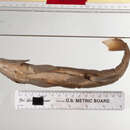en
names in breadcrumbs


Acrocheilus alutaceus és una espècie de peix de la família dels ciprínids i de l'ordre dels cipriniformes.
Els mascles poden assolir els 30 cm de longitud total.[3][4]
Es troba a Nord-amèrica.[3]
Acrocheilus alutaceus és una espècie de peix de la família dels ciprínids i de l'ordre dels cipriniformes.
The chiselmouth (Acrocheilus alutaceus) is an unusual cyprinid fish of western North America. It is named for the sharp hard plate on its lower jaw, which is used to scrape rocks for algae. It is the sole member of the monotypic genus Acrocheilus and is a close relative of the Gila western chubs.[2]
The chiselmouth's body plan generally follows the standard cyprinid form, generally elongated and slightly compressed. The snout is very blunt, with the lower jaw's plate (which consists of cornified epithelium) jutting out slightly. Coloration is rather drab, dark brown above and lighter lower down. Many individuals also have a pattern of black dots, and younger fish may have a dark area at the base of the tail. The single dorsal fin has 10 soft rays, while the anal fin and well-developed pelvic fins each have 9-10 rays. Chiselmouths can reach a length of 30 cm (12 in).
Chiselmouths are typically found in warmer parts of streams and rivers in the drainages of the Columbia River, Fraser River, and the Harney-Malheur system of the Great Basin. Some are found in lakes, migrating into streams to spawn. Although abundant in many parts of their range, behavior remains little-known. Chiselmouth were among the fishes typically utilized by the Nez Perce people as food.[3]
Young fish feed on surface insects. When the chisel develops (at around 0.6 inches length), they shift to scraping, making short darting movements at the substrate to dislodge whatever is on it, and sucking it in. Although they consume filamentous algae, it seems to not be digested much despite a long coiled intestine, and their primary food actually consists of diatoms.
The chiselmouth (Acrocheilus alutaceus) is an unusual cyprinid fish of western North America. It is named for the sharp hard plate on its lower jaw, which is used to scrape rocks for algae. It is the sole member of the monotypic genus Acrocheilus and is a close relative of the Gila western chubs.
Acrocheilus alutaceus es una especie de peces de la familia de los Cyprinidae en el orden de los Cypriniformes.
Los machos pueden llegar alcanzar los 30 cm de longitud total.[1][2]
Es ovíparo.
Es un pez de agua dulce.
Se encuentran en Norteamérica.
Es inofensivo para los humanos.
Acrocheilus alutaceus es una especie de peces de la familia de los Cyprinidae en el orden de los Cypriniformes.
Acrocheilus alutaceus Acrocheilus generoko animalia da. Arrainen barruko Actinopterygii klasean sailkatzen da, Cyprinidae familian.
Acrocheilus alutaceus Acrocheilus generoko animalia da. Arrainen barruko Actinopterygii klasean sailkatzen da, Cyprinidae familian.
Acrocheilus alutaceus
La Bouche coupante (Acrocheilus alutaceus) est une espèce de poissons de la famille des Cyprinidae vivant en Amérique du Nord. C'est la seule espèce de son genre Acrocheilus (monotypique).
Cette espèce vit dans les cours d'eau du Canada et des États-Unis[1].
Acrocheilus alutaceus
La Bouche coupante (Acrocheilus alutaceus) est une espèce de poissons de la famille des Cyprinidae vivant en Amérique du Nord. C'est la seule espèce de son genre Acrocheilus (monotypique).
Kaltasnukės (Acrocheilus) – karpinių (Cyprinidae) šeimos žuvų gentis.
Gentyje vienintelė rūšis – Acrocheilus alutaceus.
Acrocheilus alutaceus is een straalvinnige vissensoort uit de familie van de eigenlijke karpers (Cyprinidae).[1] De wetenschappelijke naam van de soort is voor het eerst geldig gepubliceerd in 1855 door Agassiz & Pickering.
Bronnen, noten en/of referenties美洲銳唇鯛(学名:Acrocheilus alutaceus)为輻鰭魚綱鯉形目鲤科的其中一種,分布於北美洲加拿大卑詩省及美國奧勒岡州、華盛頓州、愛達荷州及內達華州,棲息於在沙與碎石上的流動潭水與支流;也在湖的邊緣中出現。成魚主要以矽藻為食;幼魚則捕食水面的昆蟲,體長可達30公分,可做為食用魚。